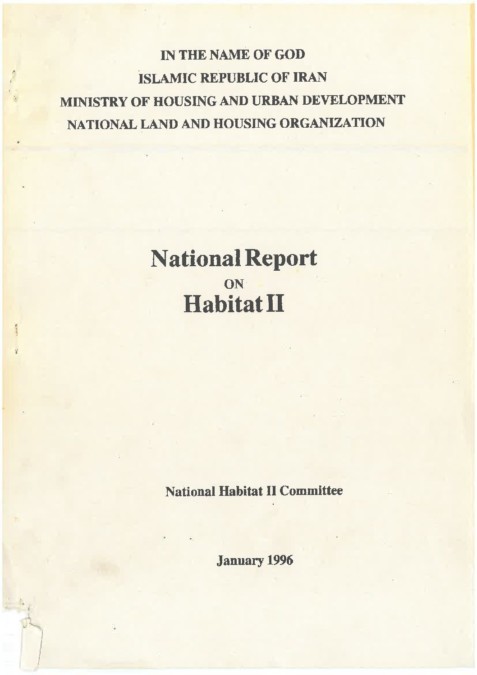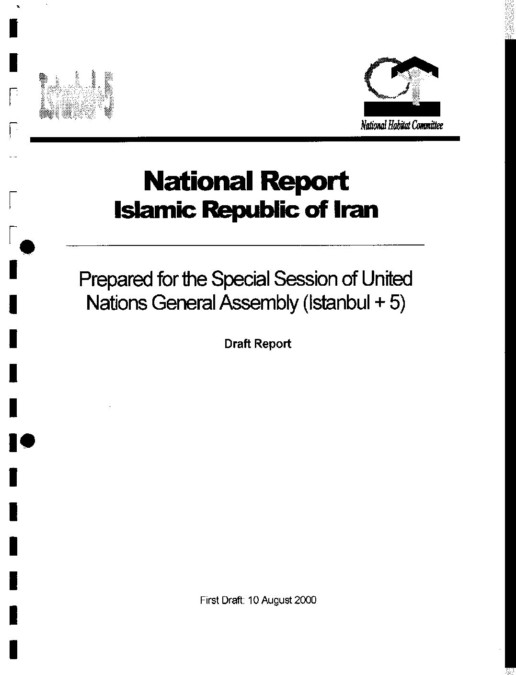
Iran (Islamic Republic of)
Urban indicators:
| Value | Year | ||
| Surface area (sq km) | 1628750 | 2014 | Land area only. |
| Population (proj., 000) | 80043 | 2016 | |
| Pop. density (per sq km) | 49.2 | 2016 | |
| Capital city | Tehran | 2015 | |
| Capital city pop. (000) | 8432 | 2015 | |
| Population growth rate (average annual %) | 1.3 | 2010-2015 | |
| Urban population growth rate (average annual %) | 2.1 | 2010-2015 | |
| CO2 emission estimates (000 tons/tons per capita) | 616976/8.0 | 2013 | |
| Population using improved drinking water sources (urban/rural, %) | 97.7/92.1 | 2015 | |
| Population using improved sanitation facilities (urban/rural, %) | 92.8/82.3 | 2015 |
National Report:
National Report Executive Summary:
Managing rapid urbanization
Accelerated urbanization and concentration of urban population in larger urban agglomerations is becoming a distinct feature of Iran’s urbanization phenomenon. During the 15 years from the Habitat II (1996-2011), Iran’s urban population increased by 45.7 percent: from 36.8 million in 1996 to 53.6 million people in 2011. During this period, the number of cities was increased by 86.1 percent: from 612 cities in 1996 to 1139 cities in 2011. The current urban population of the country is estimated to be 65.93 million people, a 12.28 million increase from the 2006 census population.
Tehran Metropolitan Region (TMR) is the most populous area in the country. Its urban population growth rate has always outpaced the national urban population growth. During this period, its urban population grew from 10.3 million in 1996 to 14.59 million people in 2011. The number of cities in TMR were increased from 25 cities of various sizes in 1996 to 55 cities in 2011. The rate of urbanization in TMR grew from 86.16 percent in 1996 to 92.79 percent in 2006, while at the national level, the rate of urbanization in 2011 was 71.39 percent. Other metropolitan regions, such as Mashad, Tabriz, Esfahan, and Shiraz also have had tremendous population growth in their regions.
Much of the population growth in TMR has occurred outside the Tehran city limits and in the cities, towns and some spontaneous settlements inside the TMR. This phenomenon requires appropriate planning and governance of these areas at the regional level.
To manage this rapid urbanization process, in addition to the existing urban development plans, several new plans were introduced and adopted at the national, regional, and metropolitan levels. The National Physical Plan (NPP) was prepared and approved by the High Council for Urban Planning and Architecture (HCUPA) in 1997. The objectives of this plan were to introduce an urban system wherein the hierarchy of urban services provision would be facilitated, the appropriate sites for future urban expansion and growth of cities would be identified, and finally a set of appropriate rules and regulations for land use for the entire Iranian territory would be devised and enforced. The NPP is currently under revision.
In the NPP, the country was divided into 10 large planning regions and a Regional Physical Plan (RPP) was to be prepared for each region. To date, 6 RPPs have been prepared and approved for implementation and the RPPs for the remaining 4 regions are under preparation.
At the metropolitan level, in 2009 the HCUPA set forth criteria and indicators for identifying country’s metropolitan regions and preparing appropriate metropolitan plans for the designated metropolitan areas of the country. To date, the Metropolitan plans for Tehran, Tabriz, Mashad, Shiraz, Esfahan and Qazvin metropolitan regions have been prepared, approved and are under implementation.
A National Urbanization Policy is currently being pursued by the Ministry of Roads and Urban Development and would be added to the existing tools to manage the rapid urbanization process of the country.
Statistics:
Urban housing indicators
People living in slums (%)
Urban population with access to adequate housing (%)
Basic services and infrastructure
Urban population with access to safe drinking water (%)
Urban population with access to adequate sanitation (%)
Urban population with access to public transport (%)
Indicators for urban policies, legislation and economy
Share of national gross domestic product (GDP) that is produced in urban areas
Statements by Iran (Islamic Republic of):
-
Habitat III Plenaries
-
Intersessionals: Informal Intergovernmental Meetings (May 2016)
Statements by other countries on behalf of G77 and China:
-
Habitat III Plenaries
-
Intersessionals: Informal Intergovernmental Meetings (May 2016)
- Statement - 18 May (by Thailand) - English Made by Thailand on Behalf of G77 and China
- Statement - 18 May (by Jamaica) - English Made by Jamaica on Behalf of G77 and China
- Statement - 19 May (by Jamaica) - English Made by Jamaica on Behalf of G77 and China
- Statement - 19 May (by Kenya) - English Made by Kenya on Behalf of G77 and China
- Statement - 20 May (by Jamaica) - English Made by Jamaica on Behalf of G77 and China
- Statement - 20 May (by Thailand) - English Made by Thailand on Behalf of G77 and China



